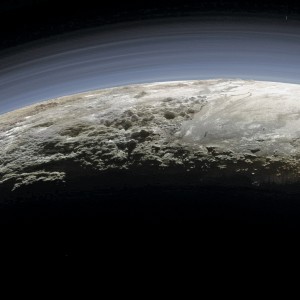When Kelsi Singer, MA ’08, PhD ’13, arrived in St. Louis as a new graduate student, she noticed a car with the bumper sticker “My other vehicle is on its way to Pluto” outside the geology building. It was Bill McKinnon’s.
Singer had always liked the icy satellites because the geology of ice, she says, “is a quirky version of geology,” so she became McKinnon’s graduate student.
Under his direction, she studied many exotic features found on icy surfaces, including giant avalanches; jumbled crazy-quilt landscapes called chaos terrain; and circular trenches, called ring-graben, that appear around large impact craters on Europa.
“It’s amazing how much you can deduce about a planet from surface features like these,” she says.
After Singer graduated from Washington University in 2013, she took a postdoctoral appointment at the Southwest Research Institute, home to Alan Stern, the principal investigator on the New Horizons mission, and she became part of the mission team. “I got one of those bumper stickers for myself then,” she says.
With New Horizons still en route to Pluto, Singer and Stern took a moment to contemplate one of the biggest mysteries about Pluto: why it has an atmosphere.
Pluto has a thin nitrogen atmosphere, but it has barely enough mass to hang onto one and, in fact, continually loses it to space. Singer and Stern calculated that Pluto loses hundreds of tons of atmospheric nitrogen each hour.
That’s a lot of nitrogen. So the obvious question is, what resupplies the atmosphere? Singer and Stern looked carefully at several possibilities and concluded that the nitrogen must be coming from inside the planet, expelled by some kind of internal activity.
This was a big, risky prediction to make — especially right before the flyby, which would immediately prove or disprove their contention.
The two submitted their paper to Astrophysical Journal Letters and prayed for a quick turnaround. The planets and the editors aligned, and during the NASA press briefing July 15, the day after the flyby, Stern announced that the paper had been accepted for publication.
The images, as we now know, showed that Singer and Stern were right. Pluto is geologically active, and Sputnik Planum is the source of the nitrogen.
I now have a new bumper sticker, Singer says: “It states, ‘My other vehicle explored Pluto.’”


Comments and respectful dialogue are encouraged, but content will be moderated. Please, no personal attacks, obscenity or profanity, selling of commercial products, or endorsements of political candidates or positions. We reserve the right to remove any inappropriate comments. We also cannot address individual medical concerns or provide medical advice in this forum.